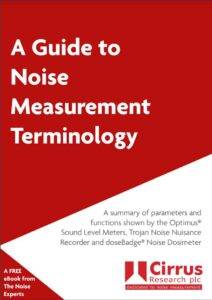You need a sound level meter, but what for?
In my 10 years experience as an Export Sales Manager, I am often approached for a Sound level meter with little additional information as to the intended use of the instrument.
Sound level meters come in a range of different configurations which lend themselves to different applications.
When enquiring to purchase a sound level meter the most important piece of information you can give Cirrus Research is the intended application.
Less experienced customers look towards Cirrus Research to recommend an instrument and without intended application information it is difficult to make such suggestions.
Therefore the most important question you can answer is why do you want to make measurements?
Often new users explain where the instrument will be used or what industry the customer is in; this information is useful but may not be sufficient as there is still a range of application that could be relevant.
Let us break down the most common applications that sound level meters are used for non-acoustically trained people:
- Basic Noise Survey â Very simple applications such as spot checking audible alarms
- Occupational Noise â The measurement of employeeâs noise exposure at work. Typically to ensure they are below legal limits for protection of employees hearing.
- Environmental Noise â The measurement of noise pollution, typically to understand the levels neighbouring people are exposed to.
Many other more specialist applications do exist.
The desired application will define the kind of sound level meter is needed, sound level meters generally are âpackagedâ for their intended application. However more advanced instruments tend to be suitable for less advanced application e.g. an environmental sound level meter can be often is used in occupational noise applications as well.
Basic noise survey sound level meters will generally offer an instantaneous noise level only, the reading on the screen will update every second and the levels will fluctuate by some degree (remember the decibel scale is logarithmic so a 3dB increase is a doubling of energy). Their use is for steady noise levels such as fire alarm noise level testing.
Occupational noise instruments offer an equivalent continuous noise measurement (Leq) and also require a peak noise measurement (Lpeak). These are the two main building blocks of the world wide Noise at Work legislations.
Further to this more advanced sound level meters for occupational noise offer 1:1 octave frequency analysis, this offers results for identification of correct hearing protection.
Finally a subset of noise monitoring instruments called noise dosemeters can be used in occupational noise applications, these are bodily worn instrument which the worker will wear throughout their working day and it will continuously measure the noise exposure. Results are normally downloaded from the instrument and viewed in software.
Environmental noise instruments will offer Leq &Lpeak measurements but additional parameters like statistical measurements (Lnâs) are also required. Additionally more specialist offers such as audio recording, timers and more advanced data logging options become available.
Also environmental instrument may require different âpackagingâ requirements â do you need them for handheld operation or are they going to be left outside permanently or temporarily? If so, weather proofing is required.
The Cirrus group offers a range of configuration to allow for hand-held, temporary or permanent noise monitoring solutions.
If you can provide some information about the application that you need the instrument for, we can make an informed decision and recommend an instrument that will meet your needs.
If you would like any information or advice about noise measurement instruments and which would suit your application, please let us know.
You can call us on 0845 230 2434 or use the contact form on this page. Alternatively, you can email sales@cirrusresearch.co.uk
Jaymee-lee Tolliday
Latest posts by Jaymee-lee Tolliday (see all)
- Turning Down the Volume: How the Trojan Noise Nuisance Recorder can help create a quieter world - 13th February 2024
- Festive Opening Hours 2023 - 6th December 2023
- Award of Excellence for Cloud-Based Monitoring Solutions 2023! - 20th November 2023

